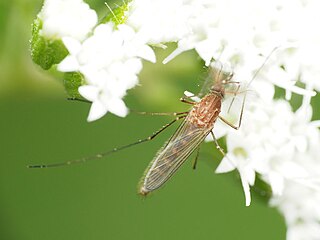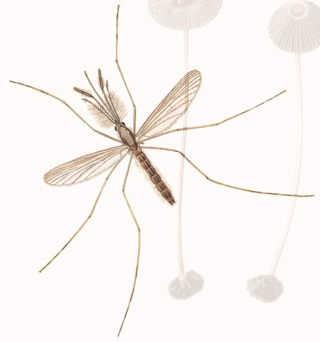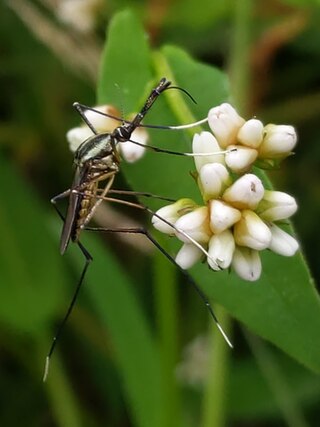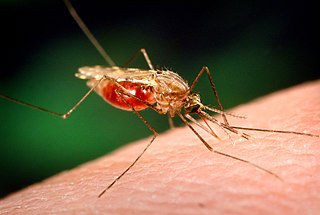
Mosquitoes, the Culicidae, are a family of small flies consisting of 3,600 species. The word "mosquito" is Spanish for "little fly". Mosquitoes have a slender segmented body, one pair of wings, three pairs of long hair-like legs, and specialized, highly elongated, piercing-sucking mouthparts. All mosquitoes drink nectar from flowers; females of some species have in addition adapted to drink blood. Evolutionary biologists view mosquitoes as micropredators, small animals that parasitise larger ones by drinking their blood without immediately killing them. Medical parasitologists view mosquitoes instead as vectors of disease, carrying protozoan parasites or bacterial or viral pathogens from one host to another.

Aedes albopictus, from the mosquito (Culicidae) family, also known as the (Asian) tiger mosquito or forest mosquito, is a mosquito native to the tropical and subtropical areas of Southeast Asia. In the past few centuries, however, this species has spread to many countries through the transport of goods and international travel. It is characterized by the white bands on its legs and body.

Anopheles is a genus of mosquito first described by J. W. Meigen in 1818. Its members are sometimes called nail mosquitoes or marsh mosquitoes. Many are vectors of the parasite Plasmodium, which causes malaria in birds, reptiles, and mammals including humans. Anopheles gambiae is the best-known species, as it transmits one of the most dangerous human malarial parasites, Plasmodium falciparum. No other mosquito genus is a vector of human malaria.

Enallagma cyathigerum is a species found mainly between latitudes 40°N and 72°N; It is widely distributed in the Palearctic, and the Nearctic species Enallagma annexum was at one time considered to be synonymous with it. The species can reach a length of 32 to 35 mm. It is common in many different countries including Russia, Sweden, Norway, Finland, the United States of America, and South Korea. Damselflies are an important link between the health of the aquatic ecosystem and its response to climate change.

Mosquito control manages the population of mosquitoes to reduce their damage to human health, economies, and enjoyment. Mosquito control is a vital public-health practice throughout the world and especially in the tropics because mosquitoes spread many diseases, such as malaria and the Zika virus.

The Culicinae are the most extensive subfamily of mosquitoes (Culicidae) and have species in every continent except Antarctica, but are highly concentrated in tropical areas. Mosquitoes are best known as parasites to many vertebrate animals and vectors for disease. They are holometabolous insects, and most species lay their eggs in stagnant water, to benefit their aquatic larval stage.

Anopheles culicifacies is a mosquito species complex and one of the primary vectors of malaria on the Indian subcontinent. It consists of five sibling species, provisionally designated as species A, B, C, D, and E. It prefers to rest indoors in cattle sheds, where it feeds on cattle. The control of A. culicifacies has become difficult due to the development of insecticide resistance against all commonly used insecticides, including new-generation insecticides such as synthetic pyrethroids.

Culex pipiens is a species of mosquito commonly referred to as the common house mosquito or northern house mosquito, as it is the most common mosquito to the northern regions of the US. They can be found in both urban and suburban temperate and tropical regions across the world.

Culex restuans is a species of mosquito known to occur in Canada, the United States, Mexico, Guatemala, Honduras, and the Bahamas. It is a disease vector for St. Louis encephalitis and West Nile virus. In 2013 West Nile Virus positive specimens were collected in Southern California.

Pantala hymenaea is a dragonfly of the family Libellulidae. It is a migratory species and is native to North, Central and South America, travelling widely and breeding in temporary water bodies. It looks very similar to the wandering glider, with the addition of a dark basal spot on the hindwing. It is a common species with a very large range and the International Union for Conservation of Nature has listed it as being of "least concern".

Culex quinquefasciatus, commonly known as the southern house mosquito, is a medium-sized mosquito found in tropical and subtropical regions of the world. It is a vector of Wuchereria bancrofti, avian malaria, and arboviruses including St. Louis encephalitis virus, Western equine encephalitis virus, Zika virus and West Nile virus. It is taxonomically regarded as a member of the Culex pipiens species complex. Its genome was sequenced in 2010, and was shown to have 18,883 protein-coding genes.

Anopheles albimanus is a species of mosquito in the order Diptera. It is found in coastal Central and South America, the Caribbean, and Mexico. It is a generalist species and capable of wide dispersion. A. albimanus is a common malaria vector.

Anopheles stephensi is a primary mosquito vector of malaria in urban India and is included in the same subgenus as Anopheles gambiae, the primary malaria vector in Africa. A. gambiae consists of a complex of morphologically identical species of mosquitoes, along with all other major malaria vectors; however, A. stephensi has not yet been included in any of these complexes. Nevertheless, two races of A. stephensi exist based on differences in egg dimensions and the number of ridges on the eggs; A. s. stephensisensu stricto, the type form, is a competent malaria vector that takes place in urban areas, and A. s. mysorensis, the variety form, exists in rural areas and exhibits considerable zoophilic behaviour, making it a poor malaria vector. However, A. s. mysorensis is a detrimental vector in Iran. An intermediate form also exists in rural communities and peri-urban areas, though its vector status is unknown. About 12% of malaria cases in India are due to A. stephensi.

Anopheles claviger is a mosquito species found in Palearctic realm covering Europe, North Africa, northern Arabian Peninsula, and northern Asia. It is responsible for transmitting malaria in some of these regions. The mosquito is made up of a species complex consisting of An. claviger sensu stricto and An. petragnani Del Vecchio. An. petragnani is found only in western Mediterranean region, and is reported to bite only animals; hence, it is not involved in human malaria.
Anopheles (Cellia) varuna is a species complex of zoophilic mosquito belonging to the genus Anopheles. It is found in India, Sri Lanka Thailand and Vietnam. It is a secondary malaria vector in Sri Lanka. Larvae are known to feed on detritus, rod and cocci bacteria, diatom, filamentous algae and desmids. A microsporidium Thelohania obscura was discovered from the larvae in India in 1966.

Toxorhynchites rutilus, also known as the elephant mosquito or treehole predatory mosquito, is a species of mosquito in the family Culicidae. Unlike most species in the genus that populate the tropics, Tx. rutilus is endemic to temperate regions. As their name suggests, these mosquitoes commonly lay their eggs in treeholes where their larvae are predators on a variety of arthropods. As with other mosquitoes, they also inhabit other bodies of stagnant water such as in a tire or artificial containers. but not large bodies of water like ponds and ground pools. Females are able to strategically locate breeding sites that already contain prey to oviposit in.

Anopheles funestus is a species of mosquito in the Culicidae family. This species was first described in 1900 by Giles. The female is attracted to houses where it seeks out humans in order to feed on their blood, mostly during the night. This mosquito is a major vector of malaria in sub-Saharan Africa.

Aedes taeniorhynchus, or the black salt marsh mosquito, is a mosquito in the family Culicidae. It is a carrier for encephalitic viruses including Venezuelan equine encephalitis and can transmit Dirofilaria immitis. It resides in the Americas and is known to bite mammals, reptiles, and birds. Like other mosquitoes, Ae. taeniorhynchus adults survive on a combination diet of blood and sugar, with females generally requiring a blood meal before laying eggs.

Anopheles atroparvus is a European species of mosquito, which was first identified in 1927. It is one of the most abundant palearctic Anopheles species belonging to the family Culicidae, commonly called mosquitoes. Although research interest in A. atroparvus has been low in the past several decades, recent concern for an increase in vector-borne disease has encouraged new research into this species.

Anopheles hermsi is a species of mosquito in the family Culicidae. It is a known vector of Plasmodium vivax malaria. An. hermsi have been collected in Southern California.





















